
肯特里奇 William Kentridge肯特里奇 William Kentridge肯特里奇 William Kentridge
肯特里奇 William Kentridge

南非艺术家肯特里奇的艺术通过非常有创意的炭笔画,印刷品,拼贴,录像和戏剧,表达出种族隔离和殖民主义下的南非。他领会到他的作品在约翰内斯堡的根深蒂固,约翰内斯堡—---那个他出生以及他继续创作的城市。














南非艺术家肯特里奇的艺术通过非常有创意的炭笔画,印刷品,拼贴,录像和戏剧,表达出种族隔离和殖民主义下的南非。他领会到他的作品在约翰内斯堡的根深蒂固,约翰内斯堡—---那个他出生以及他继续创作的城市。














Kentridge drawing in his studio, Johannesburg (Copyright of the artist)
相关文章
简历(英)
简历(中)
殖民地风景——南非艺术家肯特里奇
Drawing, Filmmaking, Theatre Are All Artist-in-Residence William Kentridge's Specialties
William Kentridge
Kentridge: master of his craft
William Kentridge | Essays & Reviews
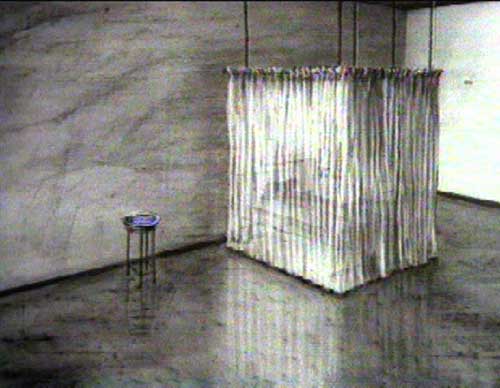
"History of the Main Complaint"
Kentridge makes animated film from his darkly disturbing charcoal drawings. They are extremely labor intensive, a week of work can yield only 40 seconds worth of film. His main concerns are the Holocaust and Apartheid in South Africa where he resides and the human tendency to forget such atrocities. The "History of the Main Complaint" is a film that reflects on collective and individual responsibility and latent pangs of conscience at past injustice. The main character, Soho Eckstein is a real estate entrepreneur who as he lies in a coma in a hospital, is haunted by images of an car accident that takes a person's life.
卡特里奇用他不安烦忧的木炭画制作动画片。这个绝对是非常密集的劳作,一个星期的工作下来只能生产40秒的影片。他主要关注的主题是他所居住--南非的大屠杀和种族隔离以及人们想忘记这些残暴回忆的倾向。在“主要抱怨的历史”这录像中,反映了集体和个人责任以及对过去不公正所潜藏剧痛的良心。片里的主角Soho Eckstein是一个房地产企业家,当他昏迷在医院里时被夺走他性命的车祸画面所困扰。
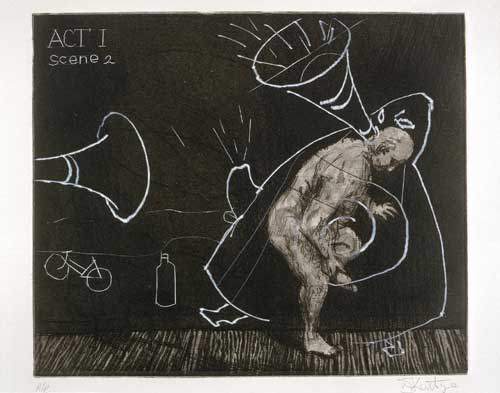
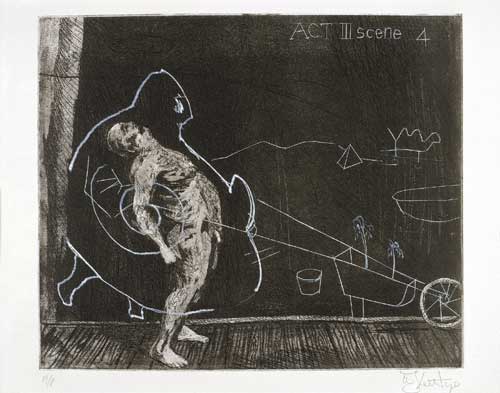
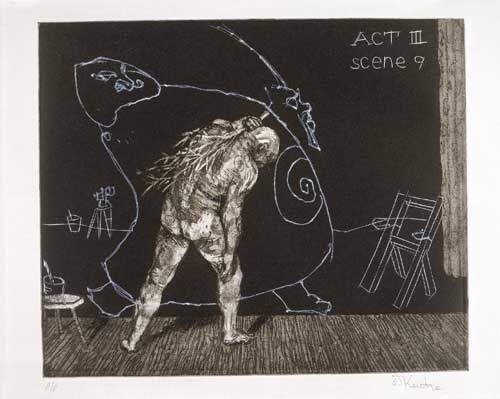
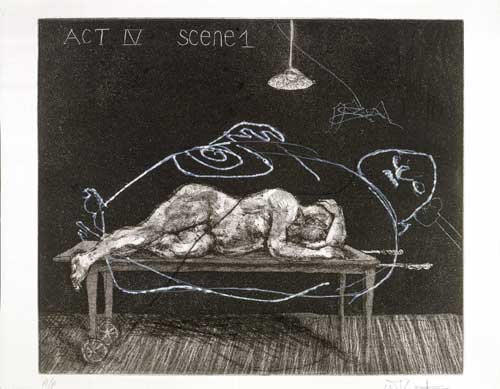
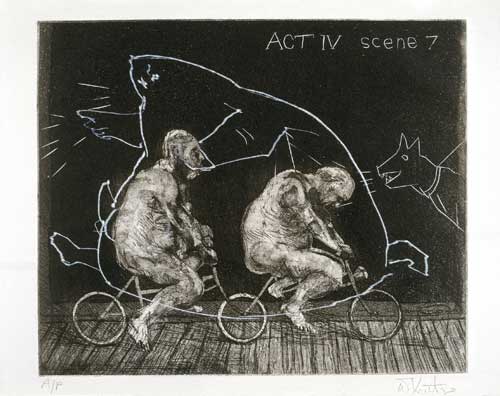
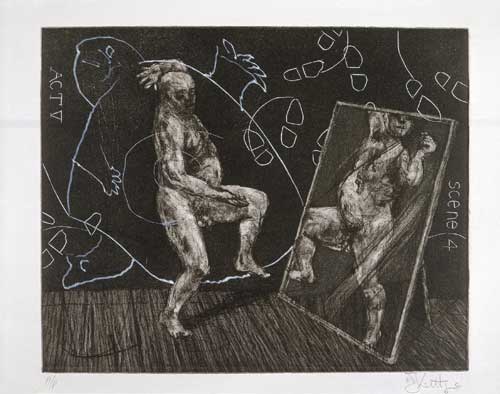
WILLIAM KENTRIDGE b. 1955
Ubu Tells the Truth
1996–97
Portfolio of eight etchings
Hardground, softground, aquatint, drypoint and engraving on paper
2001-5-1, museum purchase

SUMMER GRAFFITI, 2002
Suite of 8 lithographs printed in 5 colors on paper, die-cut with round corners prior to printing

Embossing press 2004
Lithograph
Edition 12/20
53 x 43 cm
采访文章
Ask the Artists: William Kentridge
采访
1,看得出来你的作品是经过非常多的劳动创作出来的。你花了多长时间去制作《体视法》?你可以解释一下你在劳动过程中的意义与及你如何去维持你的焦点和动力吗?
这个作品需要非常多的劳动力。《体视法》画了9个月的时间完成 – 当中有些歇息去旅行与及展览。其中时间很长是因为没有手稿和情节串连图板—灵感都是在制作中产生的。
《体视法》的结构里,最初四个月的工作都被抛弃了。动力 – 因为工作的很慢,除非做的很快,要不然根本永远都不可能去完成。所以每天都要去做。制作电影就是关于寻找焦点,寻找电影的主题。如果一早就有情节安排,那么就很难去维持这个主题了; 也因为灵感是非常即兴的,所以它成为了其中的主体。
2,《体视法》的背景音乐非常的令人印象深刻。是不是特地为此片而作的呢?如果是,你也参与其中吗?
音乐是由南非的作曲家Philip Miller 制作的,他曾经为我的四个片子作曲。他在制片的最初几个月便参与了,如果有几分钟时间,我们俩就会坐在编辑桌上,加上一些曲谱,从Monteverdi的到爵士的,跟着便是去了解片子中的音乐语法。然后我们工作的很紧密, 在片子即将要完成的时候曲子也渐渐的更完整了。
3,那些重复出现的元素(猫和蓝线等)在你的作品中是否象征着什么?
他们看起来很有意思,但是我不敢肯定是什么。猫和蓝色的线,制作开始的时候并没有任何意义的,所以现在我也不能解释猫象征什么,如果有意义,那么我便可以知道我当时为什么需要这只猫了。蓝色的线只是影片画面上所需要作为沟通的线。
4,为什么你会选择在片子利用分开的屏幕呢?
嗨! 这片子就叫着Stereoscope立体镜,一个需要两个分开的图片建立三维效果的机器。还需要更多的解释吗?
5,《体视法》是否从一些特效的南非历史事件中得到灵感呢?
没有特别的南非历史事件。影片中最后部分城市混乱的场景是根据我工作时的报纸和电视上收集的----- 在雅加达街上殴打学生的警察,莫斯科的骚乱,刚果--被丢下桥的造反者,肯雅----有人在美国大使馆前扔石头。但是,当然其他的图片都是约翰内斯堡。
Question 1: Your works appear very labor intensive. How long did it take you to create Stereoscope? Can you talk a little bit about the significance of your laborious process and how you maintain momentum and focus?
The work is very labour intensive. Stereoscope took 9 months to make - with some breaks for travel and exhibitions during that period. It takes a long time because there is no script or storyboard - the ideas are worked out in the making. In the construction of Stereoscope, most of the first four months work had to be abandoned.
Momentum - because the work is so slow, unless one works fast and intensely, the project would never get finished. So one has to begin each day running. Making the film is about finding the focus, finding what the film is about. If the film had been storyboarded, it would be difficult to maintain focus; but because it is thought out as it is done, that becomes part of the subject.
Question 2: The music in Stereoscope is very striking. Was it composed specifically for the work? If so, were you involved in that process?
Music. Philip Miller, a South African composer, wrote the music for the film. He has written music for four of my films. His involvement comes at quite an early stage - after a couple of months, when there are a few minutes of rushes to look at, we sit look at them at an editing table, with different pieces of music - anything from Monteverdi to jazz - and try to understand the musical grammar of the film. From then on we work closely, and the music becomes more and more precise as the film nears completion.
Question 3: Are the recurring elements (like the cat and the blue line, etc.) in your work symbolic of something?
They seemed meaningful, but I wasn't sure of what.
Re the cat and blue line. I never start with a meaning, so cannot tell you what the cat symbolises, if anything - I simply knew that I needed a cat at that moment of the film. Blue lines are simply a literal drawing of different lines of communication in the film.
Question 4: Why did you choose to use a split screen in some parts of the video?
Come on! The film is called Stereoscope, a machine which needs two separate images to make one three-dimensional view. Any more clues needed?
Question 5: Was Stereoscope inspired by specific events in South African history?
No specific events in SA history. The section of chaos in the city towards the end of the film contains images from newspapers and TV from the weeks in which I was working on that part - police beating students in Jakarta, Indonesia; riots outside banks in Moscow, Russia; rebels being thrown over a bridge, and then shot at in the river below, Kinshasa, Congo; someone picking up rubble to throw at a building - US embassy in Nairobi, Kenya. But of course the images are all of Johannesburg.
Ask the Artists: William Kentridge
采访
1,看得出来你的作品是经过非常多的劳动创作出来的。你花了多长时间去制作《体视法》?你可以解释一下你在劳动过程中的意义与及你如何去维持你的焦点和动力吗?
这个作品需要非常多的劳动力。《体视法》画了9个月的时间完成 – 当中有些歇息去旅行与及展览。其中时间很长是因为没有手稿和情节串连图板—灵感都是在制作中产生的。
《体视法》的结构里,最初四个月的工作都被抛弃了。动力 – 因为工作的很慢,除非做的很快,要不然根本永远都不可能去完成。所以每天都要去做。制作电影就是关于寻找焦点,寻找电影的主题。如果一早就有情节安排,那么就很难去维持这个主题了; 也因为灵感是非常即兴的,所以它成为了其中的主体。
2,《体视法》的背景音乐非常的令人印象深刻。是不是特地为此片而作的呢?如果是,你也参与其中吗?
音乐是由南非的作曲家Philip Miller 制作的,他曾经为我的四个片子作曲。他在制片的最初几个月便参与了,如果有几分钟时间,我们俩就会坐在编辑桌上,加上一些曲谱,从Monteverdi的到爵士的,跟着便是去了解片子中的音乐语法。然后我们工作的很紧密, 在片子即将要完成的时候曲子也渐渐的更完整了。
3,那些重复出现的元素(猫和蓝线等)在你的作品中是否象征着什么?
他们看起来很有意思,但是我不敢肯定是什么。猫和蓝色的线,制作开始的时候并没有任何意义的,所以现在我也不能解释猫象征什么,如果有意义,那么我便可以知道我当时为什么需要这只猫了。蓝色的线只是影片画面上所需要作为沟通的线。
4,为什么你会选择在片子利用分开的屏幕呢?
嗨! 这片子就叫着Stereoscope立体镜,一个需要两个分开的图片建立三维效果的机器。还需要更多的解释吗?
5,《体视法》是否从一些特效的南非历史事件中得到灵感呢?
没有特别的南非历史事件。影片中最后部分城市混乱的场景是根据我工作时的报纸和电视上收集的----- 在雅加达街上殴打学生的警察,莫斯科的骚乱,刚果--被丢下桥的造反者,肯雅----有人在美国大使馆前扔石头。但是,当然其他的图片都是约翰内斯堡。
Question 1: Your works appear very labor intensive. How long did it take you to create Stereoscope? Can you talk a little bit about the significance of your laborious process and how you maintain momentum and focus?
The work is very labour intensive. Stereoscope took 9 months to make - with some breaks for travel and exhibitions during that period. It takes a long time because there is no script or storyboard - the ideas are worked out in the making. In the construction of Stereoscope, most of the first four months work had to be abandoned.
Momentum - because the work is so slow, unless one works fast and intensely, the project would never get finished. So one has to begin each day running. Making the film is about finding the focus, finding what the film is about. If the film had been storyboarded, it would be difficult to maintain focus; but because it is thought out as it is done, that becomes part of the subject.
Question 2: The music in Stereoscope is very striking. Was it composed specifically for the work? If so, were you involved in that process?
Music. Philip Miller, a South African composer, wrote the music for the film. He has written music for four of my films. His involvement comes at quite an early stage - after a couple of months, when there are a few minutes of rushes to look at, we sit look at them at an editing table, with different pieces of music - anything from Monteverdi to jazz - and try to understand the musical grammar of the film. From then on we work closely, and the music becomes more and more precise as the film nears completion.
Question 3: Are the recurring elements (like the cat and the blue line, etc.) in your work symbolic of something?
They seemed meaningful, but I wasn't sure of what.
Re the cat and blue line. I never start with a meaning, so cannot tell you what the cat symbolises, if anything - I simply knew that I needed a cat at that moment of the film. Blue lines are simply a literal drawing of different lines of communication in the film.
Question 4: Why did you choose to use a split screen in some parts of the video?
Come on! The film is called Stereoscope, a machine which needs two separate images to make one three-dimensional view. Any more clues needed?
Question 5: Was Stereoscope inspired by specific events in South African history?
No specific events in SA history. The section of chaos in the city towards the end of the film contains images from newspapers and TV from the weeks in which I was working on that part - police beating students in Jakarta, Indonesia; riots outside banks in Moscow, Russia; rebels being thrown over a bridge, and then shot at in the river below, Kinshasa, Congo; someone picking up rubble to throw at a building - US embassy in Nairobi, Kenya. But of course the images are all of Johannesburg.
[wmv]http://www.awn.com/mag/issue3.7/3.7clips/9810kentridge.mov[/wmv]
6 Soho Eckstein
Soho Eckstein is a fat person; some kind of real-estate magnate. With his striped suits and pudgy features, you would place him somewhere between Bolshevik caricatures of capitalists and the expressionist images of the Weimar Republic.
6 Soho Eckstein
Soho Eckstein is a fat person; some kind of real-estate magnate. With his striped suits and pudgy features, you would place him somewhere between Bolshevik caricatures of capitalists and the expressionist images of the Weimar Republic.
影子队列
Shadow Procession
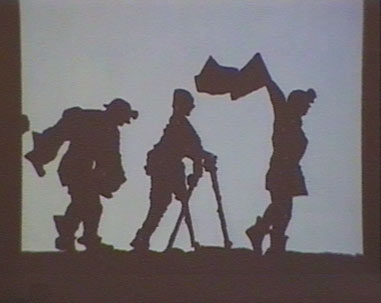
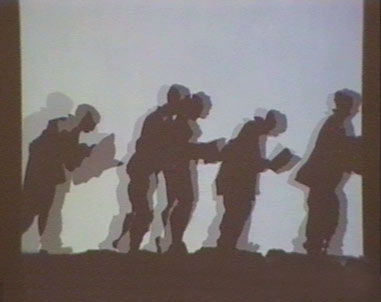
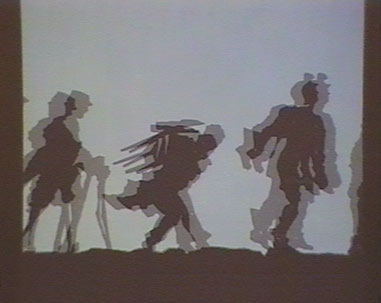
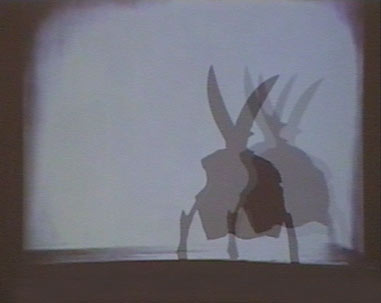
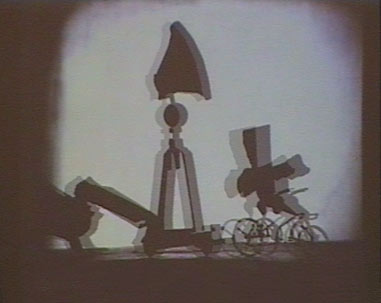
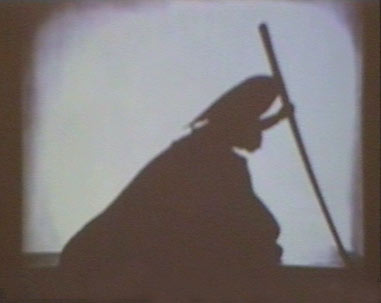
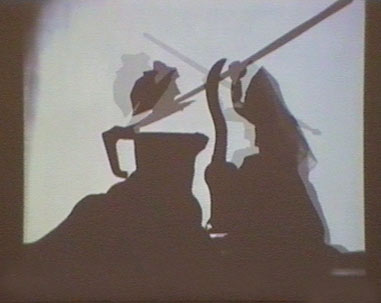
在这个《影子队列》(1999)作品里,肯特里奇用了影子剧(shadow-theatre)的技巧 :于其用图画制作肯特里奇创造了黑色的剪纸从左侧游向右侧。
影子队伍从非常感动的场面开始,人形轮廓舞蹈般的反着萦绕人心的约翰纳斯堡街头音乐家的赞美诗歌游出。一排排背着很多东西的人形出现了,有的背着麻袋,有的是悬挂在绞刑架上的矿工,拉着整个街坊的工人等。我们不知道他们从哪儿来,或者他们正在逃忙,但是我们知道他们坚决要走到那个地方。
Extract from an essay by Ari Sitas
In his animation titled Shadow Procession (1999), Kentridge uses the techniques of shadow-theatre: instead of working with drawings he creates dark cut-out forms who are then made to parade from the left hand side of the screen to the right.
Shadow Procession starts with an emotive display, figures choreographed to move against the haunting hymnody of a Johannesburg street-musician. Rows of displacees with their burdens, their stacks, including a miner dangling from the gallows, including workmen carrying entire neighbourhoods and city-scapes. We do not know where they coming from or whether they are fleeing or where they are going, but in their movement we know they are determined to get there.
A second part starts with echoes of the militant toyi-toyi chants of South Africa's insurrection, punctuated by militarised and combative slogans. We see the Ubu figure, an actor's shadow with an oversized belly and the Jarry "hood" with larger than life hands dancing in total satisfaction and self-absorption to the rhythms of drums.
A self-confident cat follows - dancing to the rhythm, limbs and motion against the call and response slogans. The sequence then explodes into the frenetic rhythms and brass of a marching band, and a new parade of cut-out figures, now totally anarchic.
Shadow Procession







在这个《影子队列》(1999)作品里,肯特里奇用了影子剧(shadow-theatre)的技巧 :于其用图画制作肯特里奇创造了黑色的剪纸从左侧游向右侧。
影子队伍从非常感动的场面开始,人形轮廓舞蹈般的反着萦绕人心的约翰纳斯堡街头音乐家的赞美诗歌游出。一排排背着很多东西的人形出现了,有的背着麻袋,有的是悬挂在绞刑架上的矿工,拉着整个街坊的工人等。我们不知道他们从哪儿来,或者他们正在逃忙,但是我们知道他们坚决要走到那个地方。
Extract from an essay by Ari Sitas
In his animation titled Shadow Procession (1999), Kentridge uses the techniques of shadow-theatre: instead of working with drawings he creates dark cut-out forms who are then made to parade from the left hand side of the screen to the right.
Shadow Procession starts with an emotive display, figures choreographed to move against the haunting hymnody of a Johannesburg street-musician. Rows of displacees with their burdens, their stacks, including a miner dangling from the gallows, including workmen carrying entire neighbourhoods and city-scapes. We do not know where they coming from or whether they are fleeing or where they are going, but in their movement we know they are determined to get there.
A second part starts with echoes of the militant toyi-toyi chants of South Africa's insurrection, punctuated by militarised and combative slogans. We see the Ubu figure, an actor's shadow with an oversized belly and the Jarry "hood" with larger than life hands dancing in total satisfaction and self-absorption to the rhythms of drums.
A self-confident cat follows - dancing to the rhythm, limbs and motion against the call and response slogans. The sequence then explodes into the frenetic rhythms and brass of a marching band, and a new parade of cut-out figures, now totally anarchic.

Stereoscope 1999


双年展展出了威廉-肯特里奇(William Kentridge)的两个动画片:《控诉史》(Hist ory of the Main Complaint,1996)和《流亡中的费利克斯》(Felix in Exi le,1994)。肯特里奇的影片以黑白的碳墨画为基础,补充以蓝彩粉笔。绘画的过程成为视觉记忆的河流,过去、未来与现在交织为整体的线条。在双年展上我们还可以看到一位来自南非约翰内斯堡白人城区的艺术家的一部新作《1999体视法》。“体视法”(Stereo scope)一词有其特殊的含义,它是一只猫在片头用毛茸茸的尾巴在幕布上所留下的字样,这只猫作为中心隐喻贯穿整个片子。这里所讲述的也是关于社会不公正的故事。与以前的电影不同,它明显地脱离了南非历史的具体背景。在这里,借助体视法,它获得了一种可传译的维度。画面不时被一蓝色竖线分割为二,这有双重目的。它成为事物重复加倍的轴,成为一个无穷尽不断重复的过程。既分离又重合这一情节贯穿该片的许多层面。以数字为基准的醉心于制作的机械性同一种对认知的渴望,随着场景的戏剧性发展,不断交替地出现。借助体视法的双重技巧能使我们清楚地看到,技术和对社会的反映是何等地相似,但又不完全相同。自动复制与翻印在摄影术,一种潜在的“凝固的明镜”--正如翁贝托-埃科(Umberto Eco)对其所称呼的那样--里可以找到它的模型或历史的起源。具省思功能的社会隔离性应归功于古老的戏剧,它允许人们作为身外之人去感受世界,以跳出自己,在他人中寻找自己,认识自己。猫,象征着动物性与人的天性中的盲目的生物动力。它从一动不动、沉默不语的演员裤袋中,从手绢的背面冒出来。在此之前“给”(GIVE)的字样以挑战的方式数次出现在已是暗如黑夜的幕布的前景中,每次又都会伴以从时间感觉上柔和得多的“FORGIVE” 。肯特里奇用“给予”和“宽恕”这寥寥几个字表现了南非和平运动的口号:应宽恕每一个在种族隔离政策调查委员会上作过证的人,应宽恕每一个愿意正视令人心情沉重的记忆的人。隔离,即体视术,这个合成词的双重含义并非伴随着善与恶的道德分野而出现,它触动的是内心世界不安宁的根源:与自己辩论和试图摆脱自己。


双年展展出了威廉-肯特里奇(William Kentridge)的两个动画片:《控诉史》(Hist ory of the Main Complaint,1996)和《流亡中的费利克斯》(Felix in Exi le,1994)。肯特里奇的影片以黑白的碳墨画为基础,补充以蓝彩粉笔。绘画的过程成为视觉记忆的河流,过去、未来与现在交织为整体的线条。在双年展上我们还可以看到一位来自南非约翰内斯堡白人城区的艺术家的一部新作《1999体视法》。“体视法”(Stereo scope)一词有其特殊的含义,它是一只猫在片头用毛茸茸的尾巴在幕布上所留下的字样,这只猫作为中心隐喻贯穿整个片子。这里所讲述的也是关于社会不公正的故事。与以前的电影不同,它明显地脱离了南非历史的具体背景。在这里,借助体视法,它获得了一种可传译的维度。画面不时被一蓝色竖线分割为二,这有双重目的。它成为事物重复加倍的轴,成为一个无穷尽不断重复的过程。既分离又重合这一情节贯穿该片的许多层面。以数字为基准的醉心于制作的机械性同一种对认知的渴望,随着场景的戏剧性发展,不断交替地出现。借助体视法的双重技巧能使我们清楚地看到,技术和对社会的反映是何等地相似,但又不完全相同。自动复制与翻印在摄影术,一种潜在的“凝固的明镜”--正如翁贝托-埃科(Umberto Eco)对其所称呼的那样--里可以找到它的模型或历史的起源。具省思功能的社会隔离性应归功于古老的戏剧,它允许人们作为身外之人去感受世界,以跳出自己,在他人中寻找自己,认识自己。猫,象征着动物性与人的天性中的盲目的生物动力。它从一动不动、沉默不语的演员裤袋中,从手绢的背面冒出来。在此之前“给”(GIVE)的字样以挑战的方式数次出现在已是暗如黑夜的幕布的前景中,每次又都会伴以从时间感觉上柔和得多的“FORGIVE” 。肯特里奇用“给予”和“宽恕”这寥寥几个字表现了南非和平运动的口号:应宽恕每一个在种族隔离政策调查委员会上作过证的人,应宽恕每一个愿意正视令人心情沉重的记忆的人。隔离,即体视术,这个合成词的双重含义并非伴随着善与恶的道德分野而出现,它触动的是内心世界不安宁的根源:与自己辩论和试图摆脱自己。
顶!!
孙猴子他师父 还没念紧箍咒 什么时候让他知道知道师父的厉害啊
[s:325] [s:325]
还以为是孙逊他爹呢。。。 看来艺术知识储备还不够 [s:326]
[strike]该楼言论已被屏蔽![/strike]
[hide=1000] 孙讯日过你妈啊,你这么追命似的搞他,就算日过你妈,你也得先做个DNA测试啊.没准你也有他的基因. [/hide]



哎···
哎~~~~

肯特大爷,您有孙子啦!

肯特大爷,您有孙子啦!
大凡国内成功的艺术家迟早都会被找到其原产地。
可悲的是,那些尚未被暴其根者,依然在那里沾沾自喜,自以为高人一筹

可悲的是,那些尚未被暴其根者,依然在那里沾沾自喜,自以为高人一筹
